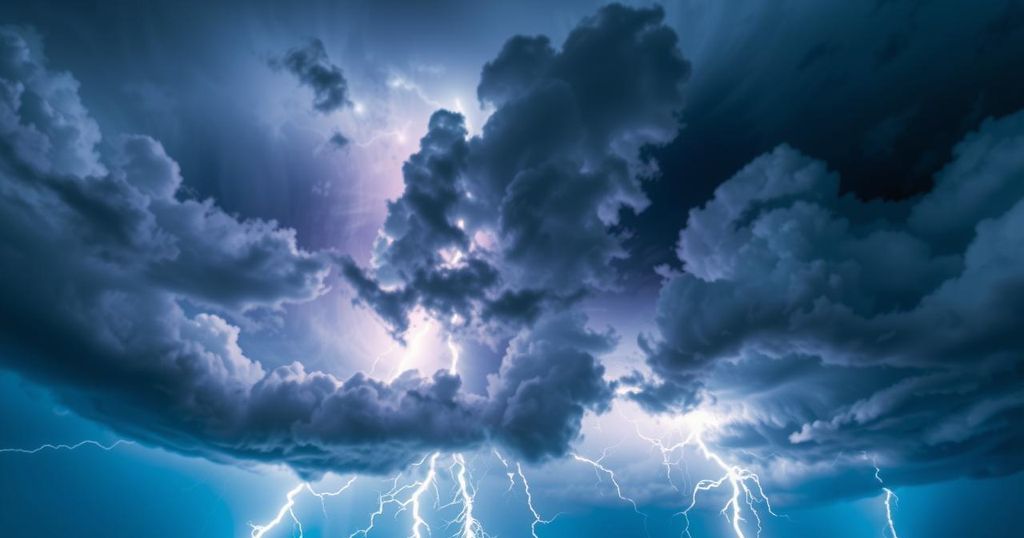Deadly Thunderstorms in Northern India Linked to Unusual Weather Patterns

Severe thunderstorms in northern India have led to at least 59 fatalities, attributed to unusual weather patterns and persistent winter disturbances. Meteorologists highlight the persistence of Western Disturbances influencing the monsoon, with implications linked to Arctic warming. The storm’s destructive nature raised significant concerns regarding future climate impacts on agriculture and infrastructure.
At least 59 individuals tragically lost their lives in northern India due to a severe thunderstorm that struck late Wednesday, resulting from unusual weather patterns. The storm predominantly affected two states, leaving a trail of destruction with multiple casualties and severe damage reported. Meteorologists attribute this extreme weather to a complex interplay of atmospheric factors, including lingering winter disturbances, abundant moisture from the surrounding seas, and intense daytime heating.
Experts are particularly concerned about the unusual persistence of Western Disturbances, which typically retreat by summer but have been seen hanging around, influencing the monsoon’s behavior. M Rajeevan, a noted meteorologist and former secretary of the Ministry of Earth Sciences, remarked that these disturbances, normally expected to move north by April or May, are now impacting summer weather, which poses a serious threat to monsoon stability. He stated, “You expect western disturbances to move north of the Indian region in April, May, June months, but we are seeing that their impact is continuing in summer.”
Moreover, the situation is eerily connected to unusual weather patterns elsewhere, such as record-breaking heat in the Arctic that is pushing cold air further south. This phenomenon has implications for mid-latitude climate systems, impacting not only places like the Eastern United States, but crucially, also India. The severe storm represents an intersection of various atmospheric influences, raising alarms for meteorologists regarding future weather patterns.
Rajeevan explained that the storm was fueled by a potent combination of cyclonic activity, ample moisture, and high temperatures, creating unstable atmospheric conditions. “There was a cyclonic circulation and a trough impacting the entire northern region,” he elaborated, which could lead to future storms if such conditions recur. It’s noted this kind of atmospheric instability, while not impossible, is certainly unusual.
Although officials from the Indian Meteorological Department (IMD) claimed there was no active Western Disturbance at the time, other experts like Mahesh Palawat offered a nuanced view. He indicated that the cyclonic circulations responsible for the thunderstorms were indeed mild Western Disturbances affecting northwestern India, indicating localized effects from larger atmospheric shifts.
Widely, Uttar Pradesh, particularly West UP, seems to have borne the worst of the storm’s impact. The fatalities were primarily due to lightning strikes, building collapses, and falling trees. Notably, a 65-year-old man in Saharanpur and a six-year-old girl in Sonbhadra tragically lost their lives due to lightning, while structural failures led to additional casualties, including an 80-year-old woman in Firozabad.
The storm’s strength was vividly evident in Delhi, experiencing wind speeds that matched those of a cyclonic storm. The fierce winds caused significant disruptions, with delayed flights and interference in Metro services. Flights at Indira Gandhi International Airport were heavily affected, marked by at least 12 diversions due to the inclement weather.
Meanwhile, meteorologists are monitoring a developing low-pressure area over the Arabian Sea that may intensify into a depression, potentially signaling an early onset of monsoon rains, yet Rajeevan expressed concern. The continuation of Western Disturbances may disrupt the monsoon’s northward journey, ultimately affecting agriculture and urban life.
The events of Wednesday serve as a pointed warning of how climate change and warmer Arctic regions can influence weather thousands of miles away, reshaping the climate dynamics that many depend on. Rajeevan emphasized the significance of these ongoing shifts in pattern, stating that tracking them is essential for understanding future weather trends that could have drastic implications for India’s monsoon system and, consequently, its agriculture and infrastructure.
The recent thunderstorms in northern India, resulting in at least 59 confirmed deaths, underscore the complex interplay of atmospheric conditions that can produce extreme weather phenomena. The persistence of Western Disturbances into summer, combined with unusual global weather patterns such as Arctic warming, appears to be disrupting expected climatic behavior, raising alarms for future monsoon stability. As experts continue to assess the implications of these conditions, it is crucial to monitor how these atmospheric changes can impact agriculture and urban infrastructure in India and beyond.
Original Source: www.hindustantimes.com







